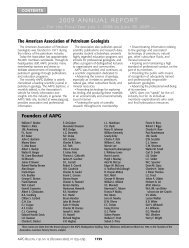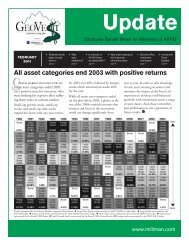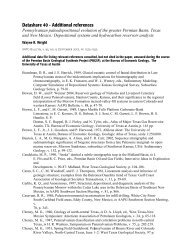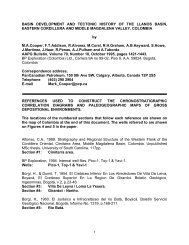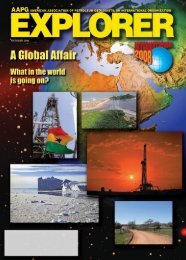Download - American Association of Petroleum Geologists
Download - American Association of Petroleum Geologists
Download - American Association of Petroleum Geologists
You also want an ePaper? Increase the reach of your titles
YUMPU automatically turns print PDFs into web optimized ePapers that Google loves.
AAPG<br />
EXPLORER<br />
Edith Allison, director <strong>of</strong> AAPG’s Geoscience and Energy Office in Washington, D.C.,<br />
can be contacted at eallison@aapg.org; or by telephone at 1-202-643-6533.<br />
POLICYWATCH<br />
56 MAY 2013 WWW.AAPG.ORG<br />
Energy industry impacts<br />
NAS Report Tracks<br />
Workforce Issues<br />
By EDITH ALLISON, GEO-DC Director<br />
The National Academy <strong>of</strong> Science<br />
recently released its report<br />
“Emerging Workforce Trends in the<br />
U.S. Energy and Mining Industries: A<br />
Call to Action,” which determines that the<br />
demand for energy and mining workers is<br />
higher than the current supply – despite<br />
<strong>of</strong>fers <strong>of</strong> high salaries.<br />
The report also<br />
concludes the<br />
demand for energy<br />
and mining workers<br />
will continue for<br />
many years, and the<br />
factors that drive the<br />
workforce shortage<br />
will grow unless<br />
corrective actions are<br />
taken.<br />
ALLISON<br />
This report is<br />
timely because major provisions <strong>of</strong><br />
the America COMPETES (Creating<br />
Opportunities to Meaningfully Promote<br />
Excellence in Technology, Education,<br />
and Science) Reauthorization Act <strong>of</strong><br />
2010 are set to expire in 2013. The<br />
Act provides, among other things,<br />
funding authorizations for federal<br />
physical sciences and engineering<br />
research programs, as well as STEM<br />
(science, technology, engineering and<br />
mathematics) education programs.<br />
The connection between quality <strong>of</strong><br />
life and energy and mining workers is<br />
simple: The nation and the world depend<br />
on energy and mineral resources to keep<br />
their people and economies thriving, and<br />
a skilled workforce is essential to meet<br />
the nation’s and the world’s energy and<br />
mineral needs.<br />
The National Academies report looks<br />
at energy sectors, including solar, wind,<br />
nuclear, and carbon capture, use and<br />
sequestration. This article will focus<br />
primarily on the oil and gas extraction<br />
industry.<br />
First Priority<br />
Accurate data and projections on<br />
the energy workforce are necessary<br />
to define the scope <strong>of</strong> labor shortages<br />
and requirements for new workers, but<br />
consistent and detailed data are lacking.<br />
A sample <strong>of</strong> the data evaluated in the<br />
National Academy report shows the<br />
inconsistencies and lack <strong>of</strong> granularity to<br />
assess specific oil and gas occupations:<br />
u PriceWaterhouseCoopers (2009)<br />
estimated the total operational oil and<br />
gas direct workforce as 2,123,291.<br />
u The Bureau <strong>of</strong> Labor Statistics (BLS,<br />
2010) estimated the U.S. workforce<br />
in oil and gas extraction, well drilling<br />
and support activities for oil and gas<br />
operations at about 494,200. This<br />
number excludes self-employed workers.<br />
u A subset <strong>of</strong> that population – the<br />
oil and gas extraction workforce, which<br />
includes self-employed workers – was<br />
estimated at 158,900 in 2010 (BLS).<br />
u The BLS projects future employment<br />
in the oil and gas extraction workforce<br />
will increase by 23,200 between 2010<br />
and 2020.<br />
u The Energy Information<br />
Administration (EIA) estimates total<br />
employment in oil and gas extraction was<br />
452,891 in 2010 and it is expected to rise<br />
to 459,032 in 2020, and then decline to<br />
404,866 in 2030 and 383,205 in 2035,<br />
as U.S. oil production starts to decline<br />
in 2030 and gas production starts to<br />
decline in 2035.<br />
There are too few<br />
younger workers to<br />
replace those who<br />
are retiring.<br />
Workforce Issues<br />
The report finds the most important<br />
factor impacting all U.S. industries is that<br />
the large cohort <strong>of</strong> baby boomers are<br />
expected to retire in the next decade,<br />
and there are too few younger workers in<br />
the pipeline to replace those retiring.<br />
Because petroleum-industry hiring<br />
was very low from the mid-1980s<br />
through about 2000, there also is an<br />
extreme shortage <strong>of</strong> geoscientists and<br />
petroleum engineers with 15 to 25 years<br />
<strong>of</strong> experience. This means a significant<br />
shortage <strong>of</strong> knowledgeable and<br />
experienced managers and mentors for<br />
younger workers.<br />
Finding ways to retain the knowledge<br />
and experience <strong>of</strong> the retiring workers is<br />
an important concern.<br />
The report also finds the current<br />
pipeline <strong>of</strong> students with strong STEM<br />
backgrounds is insufficient to meet<br />
industry needs, and efforts to grow this<br />
population are insufficient to meet future<br />
industry needs. Although the majority <strong>of</strong><br />
energy and mining jobs do not require<br />
a four-year degree, many do require<br />
some education beyond high school;<br />
for example, there is a large demand for<br />
geological and engineering technicians<br />
with a two-year degree or certificate.<br />
One bright spot is that community<br />
colleges have rapidly moved to provide<br />
two-year industry-focused programs and<br />
help funnel students into four-year STEM<br />
curricula.<br />
Other workforce issues face the oil<br />
and gas industry:<br />
u The U.S. petroleum industry faces<br />
growing international competition for<br />
workers as oil and gas production<br />
grows around the world. The problem is<br />
amplified because many foreign students<br />
in U.S. colleges and universities do<br />
not stay in the United States due to the<br />
difficulty in getting work visas.<br />
u There is a shortage <strong>of</strong> faculty in<br />
geoscience and petroleum engineering.<br />
Although the faculty decline has slightly<br />
reversed in petroleum in recent years,<br />
it is expected to grow as older faculty<br />
members retire.<br />
u Federal and state governments<br />
See Workforce, page 58







